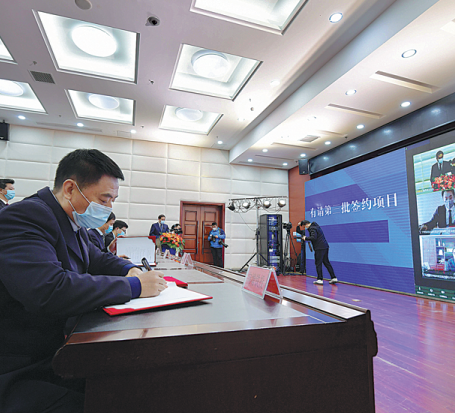Exporters casting gaze homewards
Overseas orders decline as epidemic wreaks havoc on global marketplace

An expected precipitous 75 percent contraction in new orders for the first half has kept Ma Yongjian sleepless some nights.
The bleak export outlook has been noticeably disheartening for the general manager of Zhejiang Feijian Industry and Trade Co Ltd, which produces beverage containers for global brands like Starbucks and Hydro Flask.
Over 60 percent of the company's 1 billion yuan ($140 million) in annual revenue recently came from exports to Europe and North America. Ma said he endured a 20 million yuan loss in February alone.
"Foreign customers have been postponing their reception of shipments, while Customs and ports in European countries and Japan have been placed on effective lockdown. This has resulted in a large stockpile of our goods and semifinished products, and severe payment delays," Ma said.
When China's business activity began to hum back to life in March, the novel coronavirus had engulfed much of the rest of the world, depressing economic activity and consumer demand in many of the Western markets that China's exporters depend on.
China's large-scale work resumption efforts had helped exporters restore at least 70 percent of their production capacity by the end of March, said the Ministry of Commerce. But many now worry that new setbacks could emerge and even linger as existing overseas orders are canceled and new orders fail to materialize.
"The crippling global growth and plunging demand are strangling Chinese exporters," said Xing Zhaopeng, an analyst at ANZ Bank.
While the World Trade Organization predicted global trade will likely plunge by between 13 percent and 32 percent this year owing to the pandemic, Li Jingfeng, head of Langtian Apparel, was even more pessimistic.
The company's export orders are likely to be slashed by 90 percent in the first half of 2020, and no signs of new orders for the second quarter have prompted Li to take some belt-tightening measures.
"I've unfortunately found myself caught in a cash flow crunch due to delayed payments and workforce reductions as many workers are forced to stay idle," Li said.
Despite the commercial carnage, the vast domestic market offers a ray of hope.
The China Council for the Promotion of International Trade said in April that over 70 percent of the 700 export-reliant enterprises surveyed by the trade group "exhibited a strong desire to turn to domestic sales".
1688.com, the country's top domestic wholesale portal, saw a 60 percent month-on-month surge in the number of newly registered companies that were previously engaged in export-related businesses in March. Sales in the same period of time almost tripled.
"To date, we've seen nearly 300,000 factories shift their business focus from exports to domestic sales on our platform, and we expect the number to top 500,000 this year," said Wang Hai, general manager of 1688.com, who is also vice-president of parent Alibaba Group.
In late March, the platform staged a massive online promotion to help domestic buyers familiarize themselves with the traditional exporters, and some have reaped initial gains.
For instance, Ma's cup manufacturing business secured 6 million yuan in orders during the one-off promotional campaign, and Hai Tao, general manager of a sock and lingerie exporter in Zhejiang province, believes he has done better than usual recently.
"We used to only deal with large business-end wholesalers who normally purchase in bulk. But they were the ones hit the hardest by the pandemic," said Hai, whose Caramella Science and Technology Co Ltd produces for brands like Happy Socks and Embry Form.
"Now e-commerce helps bridge us with smaller-scale merchants that were previously unattainable to us," he said. "They may start ordering socks of just 30 to 50 pairs each time, but given the sheer numbers, they constitute a stable source of income."
In a news briefing on April 10, Ren Hongbin, assistant minister of commerce, said the government will encourage strengthened cooperation between exporters and leading domestic e-commerce platforms by showcasing quality export merchandise to Chinese shoppers and accelerating their circulation in the domestic market.
But the transformation is by no means an easy feat. The first challenge lies in the different requirements by domestic and foreign customers.
"Under the previous model of doing bulk trading, we are fairly distant from end users so that we basically produce products based on what we are told. But now we need to be a lot more nimble and responsive to local customer needs," Ma said.
For businesspersons like Ma, the previously unexplored domestic retail sector offers a glimpse of the power of "data analytics"-the need to have a clearer picture of customer profiles, their predispositions and the timing and even tactics of new product launches.
Market knowledge is increasing thanks in part to a broader initiative launched by Alibaba called "2020 Spring Thunder Initiative", which aims to help small and medium-sized enterprises in China succeed during the trying circumstances of the novel coronavirus pandemic.
To achieve this, Alibaba is fostering 10 digitized manufacturing clusters with production output valued at tens of billions of yuan. The group hopes this will help some 1,000 factories realize direct-to-consumer sales of over 100 million yuan per factory within three years.
For 1688.com, it will facilitate export companies to set up virtual storefronts on its site, launch dedicated promotional campaigns to boost sales and help identify prospective buyers through digital presentations.
"The consumer insights we've obtained stand to provide invaluable advice on pricing, customer preferences, sales channels and marketing techniques. We also help merchants with destocking and devise popular items through special campaigns," Wang said.
Hai said a comprehensive command of customer needs buoyed by statistics has equipped him with much better market sensitivity, and such a data-driven approach is being applied and optimized within the plant's daily operations.
"Now we can cease producing unmarketable goods outright and add production capacity to those sought-after items. It helps us stay informed of market trends," he said.
Among value-added services offered by 1688.com, Wang said, are free online courses that systematically provide export-driven business owners with basic e-commerce know-how and logistics solutions that help companies handle random, scattered orders.
Li from Langtian Apparel approved of the "flexible manufacturing" model, saying the demand-driven approach not only helps chip away at stockpiles, but unexpectedly brings about a lasting and more enterprising change-a surge in profitability.
"Despite growing complexity in customer orders, all of our staff now prefer to do domestic sales because they generate far bigger margins compared with traditional OEM, or original equipment manufacturer-based foreign trade," said Li.
Zhong Jialiang, vice-general manager of Guangdong Jinhui Knife and Scissors, which mass produces on behalf of German kitchenware brand Zwilling, concurred that the status quo has propelled him to revisit the OEM model: manufacturing based on requirements and getting minimal margins.
"To be honest, we were initially forced to turn to the domestic market via e-commerce channels amid the pandemic. But our products are sold at much more lucrative prices at home than abroad," Zhong said, adding that profitability could potentially be many times higher in the domestic market compared with overseas sales.
"That's why we are about to change our business portfolio, from an even distribution of domestic sales and foreign trade, to 90 percent of sales targeting the domestic market," he said.




Today's Top News
- Xi stresses improving long-term mechanisms for cyberspace governance
- Experts share ideas on advancing human rights
- Japan PM's remarks on Taiwan send severely wrong signal
- Key steps to boost RMB's intl standing highlighted
- Sustained fight against corruption urged
- Xi calls for promotion of spirit of volunteerism






























